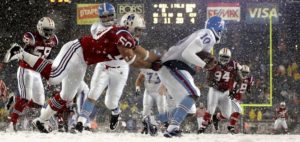This was a very good Saints team — that win brought New Orleans to 5-2 — and if you were picking a team to win the next week, you probably would have picked the Saints. The Saints were favored by 14 points against the Rams, but were upset, 31-21.
In 2014, the Matt Ryan-led Atlanta Falcons dominated the Bucs in a Thursday Night massacre. Atlanta won 56-14 in a game where the victors produced a record Game Script of 32.6! At 2-1, Atlanta looked like a team on the rise, but the Falcons lost in Minnesota the next week as 3-point favorites.
It feels inconceivable that a team could look so good one week and lose the next. And even more common is the team on the losing end of a humiliating loss turning things around immediately.
In recent years, the three worst blowouts were the Rams crushing the Raiders 52-0 in 2014, the Falcons demolition against the Bucs described above, and a 58-0 win by Seattle against the Cardinals. The very next week, Oakland, Tampa Bay, and Arizona not only all won, but all won as touchdown underdogs!
My favorite example comes from the 1983 Oilers. In 1982, Houston was terrible, going 1-8. They opened the ’83 season with 9 straight losses, and in the 10th game, lost to the Bengals 55-14 and trailed 48-0 after three quarters. And yet, the next week, as 6-point home underdogs, the Oilers won for just the second time in 20 games.
Okay, one more favorite example. In 2009, the Patriots destroyed the Titans, 59-0, on a snow-covered field in Foxboro. Tennessee dropped to 0-6 after the game, and switched quarterbacks from Kerry Collins to backup Vince Young. The Titans responded by winning five straight games!
In week 1, the Ravens dominated a Miami team that most assume is tanking. Baltimore finished the game with a remarkable +30.0 Game Script, qualifying by any measure as one of the biggest blowouts in recent memory. And while our eyes say Baltimore (a 13.5-point favorite at home against Arizona) and Miami (a 19-point underdog at home against the Patriots) will have similar performances in week two, history says we should exercise some caution in our projections.
I looked at every game since 1978 (which is as far back as we have points spread data) and calculated an adjusted game score for each game. What’s an adjusted game score? It’s an average of 5 numbers: the scores at the end of each of the four quarters, and 0. This is intended to be a very rough approximation of Game Script and is much easier to calculate! For example, in the Ravens game, they were up 21 after the 1st quarter, 32 after the 2nd, 42 after the 3rd, and 49 after the fourth; the average of [0, 21, 32, 42, 49] is 28.8, so that’s what the Ravens adjusted game score is from their week 1 performance.
That ranks as the 8th-highest adjusted game score since 1978. What’s interesting is that 3 of the 7 teams with better scores went on to lose the next week, with two of them doing so as favorites. You can click on those teams in the links in the table below, which shows all teams to produce an adjusted game score of 27.0 or better in a regular season game, and how those teams fared the next game.
And here is the same result for the teams on the losing side of things. Remarkably, 5 of the 6 teams that suffered the worst losses won the next week, with 4 of them as underdogs!
Does this mean the Dolphins are going to pull off the upset of the century against the Patriots on Sunday? Probably not. But in the NFL, you never know. After all, the 2006 Bears were 7-0 and just obliterated the 49ers, before losing at home as 13.5-point favorites to the … Dolphins.

